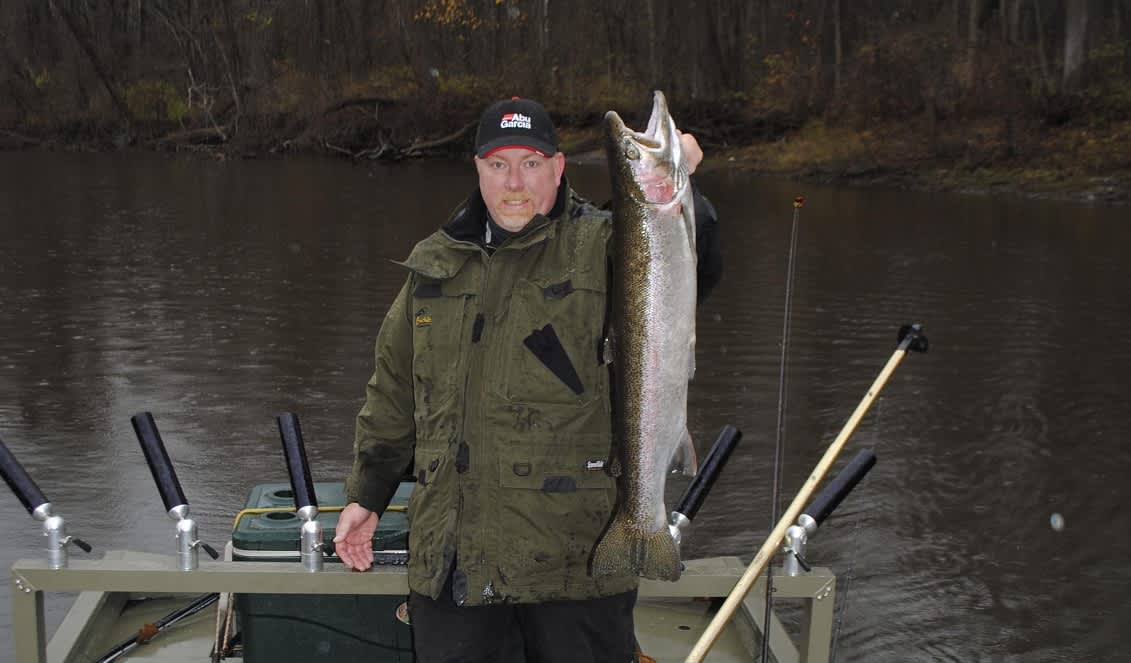Plugs for Kalamazoo River Steelhead
Bob Gwizdz 12.02.13

Miles Hanley is a bass fisherman and, as you might guess, spends a lot of time in a bass boat. But when autumn arrives—and the steelhead begin heading upstream—Hanley is glad to switch gears and target the rainbows.
The bass boat is not exactly well-suited to the technique he prefers: running plugs back in the current. And, with well-appointed river boats costing nearly as much as bass boats, well, a guy can’t afford two top-of-the-line rigs, now can he?
So Hanley, a boat salesman at D & R Sports Center in Kalamazoo, went in another direction. He decided to build a river boat, starting with a heavy-duty johnboat (a 17-foot Tracker Grizzly). He fabricated a front/center console, built a structure for rod holders for the stern, put a 40-horse jet drive Mercury on it, a winch on the front for the anchor, and wound up with what he describes as an “affordable” river boat.
“This one, as rigged, is about $18,000, but I’ve got a lot of expensive accessories,” Hanley explained. “I’ve got a $700 fish finder, a $1,500 trolling motor, and even the rod holders cost $95 apiece. You could save money by going with a prop (outboard). You could get by with less—around $15,000.”

Hanley invited me to check out his creation on the Kalamazoo River recently, where he’s been beating up on steelhead this season. So on a cold, rainy, pre-deer season day, I joined him.
We ran plugs; Hanley was using Brad’s Wigglers, West Coast crankbaits that bear a strong resemblance to Wiggle Warts but are available in some colors that Storm doesn’t offer. That was the key; “sometimes color makes all the difference,” he said.
It started slowly. For two hours, beginning shortly after dawn, we did nada.
“I can guarantee you we’re around fish,” Hanley said, and it was obvious as we saw them swirling and porpoising and sharking all around us. “It’s just a matter of putting it in front of one with the right attitude.”
At 8:50 a.m. it happened; a male steelie engulfed a gold/orange bait and we soon had it in the net. It was like flipping a switch. Within 30 minutes, we’d put three more in the boat.
We were running the baits on 8-1/2-foot medium-action rods and bass-class Abu Garcia reels, spooled with either 17-pound monofilament or heavier braid (a tip: the braided line was better for clearing the leaves that littered the surface and occasionally hung up on the line). Recent rains had raised and colored the water, so light line wasn’t critical, Hanley said.
“Right now they’re not line-shy and I want to get away with as heavy a line as I can,” he said. “In the winter, when the water’s low and gin-clear, I’ll run 12-pound fluorocarbon because they do get line shy.”
Using a remote-controlled Minn Kota trolling motor, Hanley covered the water thoroughly, fishing no more than 100 yards in our first two hours in four to seven feet of water.
“I don’t fish deep holes much,” Hanley said. “The feeding fish, I think, are in the runs. And steelhead like current. They’re used to it. They may not be in the main current—they might be on the edge of a seam or something—but when they get to feeding heavy, I think they get right in there where the current is ripping.
“They don’t seem to be in the eddies like smallmouth bass or walleyes.”

Although he’s done his share of spawn fishing over the course of his angling career, Hanley prefers to run plugs, a technique that has faded from favor in recent years as more guys use bobbers. But to Hanley there’s no comparison.
“When they hit a plug they can run 20 yards of line off your reel before you can even get it out of the rod holder,” he said. “Then they jump and cross lines and get all tangled up—it’s a challenge. I’d just as soon see that rod tip ripped down as watch a bobber go under. And I can fish three rods.
“And I’m fishing from bank to bank, covering more water than a guy who anchors and fishes a run. It’s just like bass fishing—covering water, getting a bite, and trying to duplicate it.”
The rain, which had been steady all morning, picked up in intensity. We caught two more fish over the next two hours—and had a couple hit that we didn’t hook—when I decided I’d had about as much fun as I could stand that morning. Hanley acknowledged that the fish had been good, but was slow in comparison to his recent exploits.
“We went 18 for 34 the other day,” he said. “We had four doubles and a triple. That was the best day of my life on the river.”
I’d say.
Hanley will fish for steelhead all winter long and, with the amount of fish in the river, he’s expecting a good year.
“They’re not going anywhere from here unless they go back out to the lake and find another river to run up,” he concluded.
And, if you’re interested in a river boat, you can contact Hanley at miles@dandrsports.com.
For more information on Michigan fishing go to michigan.org. Click here to purchase a Michigan fishing license online.

